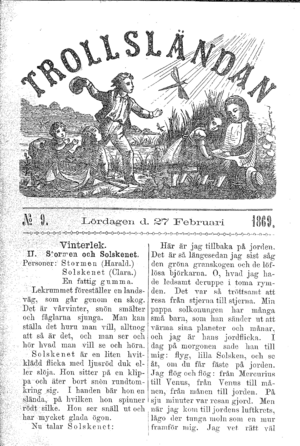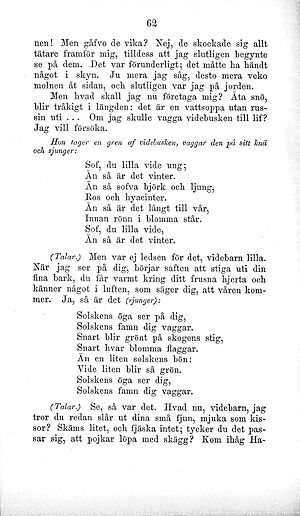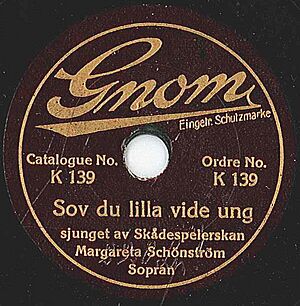Sov du lilla vide ung facts for kids
Sov du lilla vide ung (which means "Sleep, you little willow young") is a famous poem. It is also known as Videvisan ("Willow song") or Solskenets visan ("Sunshine's song"). The poem was written by the author Zachris Topelius. It first appeared in a children's magazine called Trollsländan ("Dragonfly") on February 27, 1869.
Zachris Topelius is thought to be the first writer in Sweden to create literature just for kids. He wrote many poems, songs, stories, and fairy tales. He also wrote plays for children. Topelius wanted his writings to be part of children's games, not just for stage shows.
Contents
The Story Behind the Song
Sov du lilla vide ung was part of a small play for children. The play was called Stormen och Solskenet ("The storm and the sunshine"). It had three characters, all meant to be played by kids.
Meet the Sunshine Character
The play describes one of the main characters, "Sunshine." She is a small girl dressed in white. She has a pink cloth or veil. Sunshine sits on a rock and seems to be melting the snow around her. In her hand, she holds a spindle. She spins red silk onto it. Sunshine looks kind, and her eyes are full of joy.
The Willow's Awakening
The play starts in early spring. The snow is melting, and birds are singing. Sunshine says she wants to bring a willow bush to life. She takes a willow branch and sings to it. Her song helps the willow feel warm. It helps the sap rise in its bark. The willow feels that spring is coming.
Sunshine then sings another part of the song. She sings about how her "eye" and "lap" help the willow. She wishes for the willow to become green. Soon, the forest path will be green. Every flower will bloom.
Music for the Poem
The most well-known music for Sov du lilla vide ung was written by the Swedish composer Alice Tegnér. She lived from 1864 to 1943.
Alice Tegnér's Version
Alice Tegnér's music for the song was published in 1895. It was in a songbook series called Sjung med oss, Mamma! ("Sing with us, Mama!"). Her version was titled Videvisan ("Willow song"). Tegnér changed the words a little to fit her tune. She also updated the spelling. Her songs were printed again in 1943 in a collection called Nu ska vi sjunga ("Now we shall sing").
Other Musical Versions
- In 1900, a composer named Preben Nodermann published his own music for the poem. He called it Solskenets visa ("Sunshine's song"). This version became popular in Denmark and Norway.
- Another Swedish composer, Ivar Hallström, also wrote music for Solskenets visa. It was published in 1931. His song had different words from both Topelius's original and Tegnér's version.
Recordings of the Song
One of the first recordings of Alice Tegnér's version was made in 1909. It was sung by Inga Berentz. In 1925, Margareta Schönström recorded the song. It was released on a small record called "Gnom." These records were made for children's toy record players.
The song has also been sung in other languages. Maria Llerena sang it in Spanish as Duerme mi Nenita. This was on her 1988 album Chiquitico mio. There are more than 100 recordings of this song listed in the Swedish media database.




